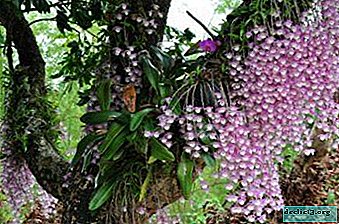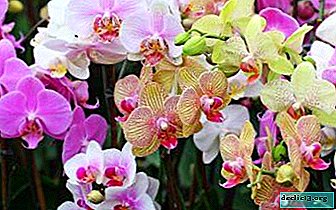Miracle of nature - Phalaenopsis orchid

Phalaenopsis are considered "orchids for beginners" - ease of care, relative unpretentiousness and bright, lush flowering make this variety just perfect for beginner growers.
Speaking of orchids, most of them imagine the magnificent inflorescence of phalaenopsis with thin, wide petals-wings. This is not surprising, because it was the representatives of this genus that first came to Europe, introducing the Old World with amazing exotic flowers - orchids.
Where is it found?
Phalaenopsis is a vast genus of orchids, whose homeland is Southeast Asia. Many species of this genus grow in the Philippines and northeast Australia. Presumably, the genus originated in southern China, from where it spread throughout the rest of the current habitat.
For the first time, a plant of this genus was found on the island of Ambon in Indonesia by the German naturalist G. Rumf. However, the phalaenopsis became a real botanical sensation after one flower came to the famous scientist Karl Linnaeus. He described it in his work "Plant Species" under the name "adorable epidendrum."
On a note. The word "epidendrum" can be translated as "living on a tree."Today, botanists and experienced growers know that in nature, almost all orchids live on treesHowever, at that time, scientists were almost unfamiliar with orchids. Subsequently, this species that came to Linnaeus became a model for describing the entire genus of phalaenopsis (the so-called nomenclature type). To this day it is called Phalaenopsis amabilis - "lovely phalaenopsis."
A familiar name appeared in these flowers in 1825, when the director of the Leiden Botanical Garden Karl Blume, traveling through the Malay Archipelago, discovered huge white flowers on tall stems in the thick of the rainforest and mistook them for night moths. The error, of course, quickly opened, but Blume decided to call these flowers phalaenopsis - from the Greek words phalania - "moth" and opsis - "similarity."
How is it growing?
 In the genus phalaenopsis, there are about 70 species. Most of them are epiphytes - plants that do not root in the soil, but live on other plants. Epiphytes are not parasites, as you might think: they do not suck out juices from other plants, but use them as "supports" or supports, trying to rise higher to sunlight. They get nutrients from litter (leaves, pieces of bark, etc.)and moisture is caught directly from the air - in tropical forests, where such plants usually live, frequent rains and thick fogs.
In the genus phalaenopsis, there are about 70 species. Most of them are epiphytes - plants that do not root in the soil, but live on other plants. Epiphytes are not parasites, as you might think: they do not suck out juices from other plants, but use them as "supports" or supports, trying to rise higher to sunlight. They get nutrients from litter (leaves, pieces of bark, etc.)and moisture is caught directly from the air - in tropical forests, where such plants usually live, frequent rains and thick fogs.
Phalaenopsis, although they lead the lifestyle of epiphytes, usually do not climb high, inhabiting the lower tiers of the rainforest. Some species even grow on stones (such species are called lithophytes).
Structure and appearance
All phalaenopsis are monopodial plants having one short stem growing vertically. Right near the ground is a rosette of leaves, the length of which can vary from 5 to 30 centimeters, depending on the species. The leaves, like all monopodial orchids, are quite thick and juicy, they accumulate moisture and nutrients in themselves, which the plant uses during periods of drought. Some species on the leaves have a characteristic pattern - light, openwork and very beautiful.
Flower lovers familiar with representatives of this genus note their slender, tall stalk, on which many large flowers bloom. In fact, this is not a stem, but a very long peduncle, which often branches. During flowering, most phalaenopsis blooms large bright flowers, in shape truly resembling butterflies.
Reference. In eighteen species, the flowers emit a fragrance - especially pleasant and strong in Phalaenopsis bellina and Phalaenopsis lueddemanniana. But in Phalaenopsis reichenbachiana and Phalaenopsis venosa, the smell, although strong, but very unpleasant.From three to forty flowers can bloom at one peduncle during flowering - their number depends on the general condition of the plant, in nature several hundred flowers may bloom on flower stalks of some species! Their color scheme is amazing - flowers can be white, bright yellow, dark purple and even blue! In many species, the petals are covered with bizarre patterns of stripes and specks. Their color is so bizarre and diverse that in Europe phalaenopsis was called the "miracle of nature."
The size of the flowers also varies depending on the particular species. - from two to thirteen centimeters in diameter. Labellum (lip) of the flower is often of a contrasting color and effectively stands out against the background of the petals.
The aerial roots of phalaenopsis, just like the leaves, are actively involved in the process of photosynthesis and have a green color.
It is curious that in nature most phalaenopsis grows not strictly vertically, but at an angle of 30-45 degrees. Some species even grow downward, hanging from the trunks and branches of support trees in huge clusters.
You will find out what orchids and phalaenopsis are and whether this plant is the same or not, what are their differences and similarities, here.
Photo
Next, you can see the photo of the plant:





Growth Conditions and Life Cycle
No wonder the orchids of the phalaenopsis genus are considered the best orchids for beginner gardeners: unlike others, they are unpretentious, and it is very easy to adjust to their life cycle. In nature, these plants bloom once or twice a year, and at home, with proper care, they can bloom even three times. Read more about caring for Phalaenopsis before, during and after flowering at home here.
Phalaenopsis practically does not have a characteristic dormant period for most orchids, during which the plant stops growing and blooming. Orchids of this genus grow almost all year round., this is facilitated by a fairly even and constant climate without sharp seasonal changes in temperature and humidity.
Important! Short-term "rest" at phalaenopsis occurs approximately in March.These orchids are so fond of gardeners precisely because of their undemandingness - they have enough heat and humidity.
Differences between domestic and wild varieties
Phalaenopsis is loved not only by gardeners, but also by breeders - to date, more than five thousand breeding species have already been bred. Of course, they are significantly different from their "wild" ancestors - many varieties of phalaenopsis have almost nothing in common with them:
- The most striking and obvious difference is growth direction. Cultivated phalaenopsis do not need support in the form of a tree and grow vertically - in contrast to uncultivated species hanging from the trunks.
- Flower sizes - in "home" plants, the flowers are much larger.
- Number of flowers on a peduncle - and here the "home" varieties already lose the "wild", peduncles of which are whole huge clusters of dozens of flowers.
Amazing exotic phalaenopsis orchids - a real miracle of nature, which a skilled florist can easily settle in his house.

















